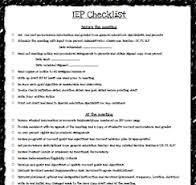
IEP Checklist: A Guide for Parents and Educators
An Individualized Education Program (IEP) is a personalized plan developed for students with disabilities to ensure they receive the support and services they need to succeed in school. Creating an effective IEP requires careful planning and collaboration between parents, educators, and other professionals.
Key Components of an IEP Checklist:
- Evaluation Results: Review assessment data to identify the student’s strengths and areas of need.
- Annual Goals: Set specific, measurable goals that address the student’s educational needs.
- Special Education Services: Determine the specialized instruction, support services, and accommodations required.
- Related Services: Include any additional services such as speech therapy, occupational therapy, or counseling.
- Transition Planning: Develop a plan for transitioning the student from school to post-school activities.
- Parent Involvement: Ensure parents are actively involved in the IEP development process.
- Annual Review: Schedule regular meetings to review and update the IEP as needed.
Benefits of Using an IEP Checklist:
An IEP checklist serves as a valuable tool for ensuring that all necessary components are considered when developing an individualized education plan. By following a comprehensive checklist, parents and educators can collaborate effectively to create a plan that meets the unique needs of each student with disabilities.
Remember, an IEP is a legally binding document that outlines the educational program designed to meet a student’s individual needs. By using an IEP checklist as a guide, parents and educators can work together to create a plan that promotes academic success and supports the overall growth and development of students with disabilities.
Essential FAQs About IEP Checklists: Key Components, Process Steps, and Communication Tips
- What is a checklist for IEP?
- What are the 3 most important parts of an IEP?
- What are the 7 steps of the IEP process?
- What not to say in an IEP?
What is a checklist for IEP?
A checklist for an Individualized Education Program (IEP) is a structured tool that outlines the key components and steps involved in developing a personalized education plan for students with disabilities. This checklist typically includes items such as reviewing evaluation results, setting annual goals, determining special education services and accommodations, planning for transition to post-school activities, ensuring parent involvement, and scheduling regular reviews. By following a checklist for IEP development, parents and educators can ensure that all necessary aspects are considered and addressed in creating an effective plan tailored to meet the unique needs of each student.
What are the 3 most important parts of an IEP?
When considering the most important parts of an Individualized Education Program (IEP), three key components stand out: annual goals, special education services, and parent involvement. Annual goals outline specific and measurable objectives tailored to address the student’s educational needs and track progress over time. Special education services encompass the specialized instruction, support services, and accommodations necessary to support the student’s learning and development. Parent involvement is crucial in the IEP process, ensuring that parents are active participants in decision-making and advocacy for their child’s educational needs. These three elements collectively contribute to the effectiveness and success of an IEP in meeting the unique requirements of students with disabilities.
What are the 7 steps of the IEP process?
The 7 steps of the Individualized Education Program (IEP) process are crucial for ensuring that students with disabilities receive the appropriate support and services they need to succeed in school. These steps typically include: 1) Pre-referral, 2) Referral, 3) Evaluation, 4) Eligibility determination, 5) Development of the IEP, 6) Implementation of the IEP, and 7) Annual review and reassessment. Each step plays a vital role in creating a personalized plan that addresses the student’s unique needs and sets them up for academic success. By following these steps diligently and involving parents, educators, and other professionals in the process, schools can effectively support students with disabilities in reaching their full potential.
What not to say in an IEP?
When participating in an Individualized Education Program (IEP) meeting, it is important to be mindful of what not to say in order to maintain a positive and productive atmosphere. Avoid making negative or judgmental comments about the student’s abilities or behaviors. Refrain from using language that could be perceived as dismissive or disrespectful towards the student, their family, or the educators involved. Instead, focus on constructive and collaborative communication that centers on finding solutions and support for the student’s educational needs. By being aware of what not to say in an IEP meeting, participants can create a more inclusive and effective planning process for the student’s educational success.
